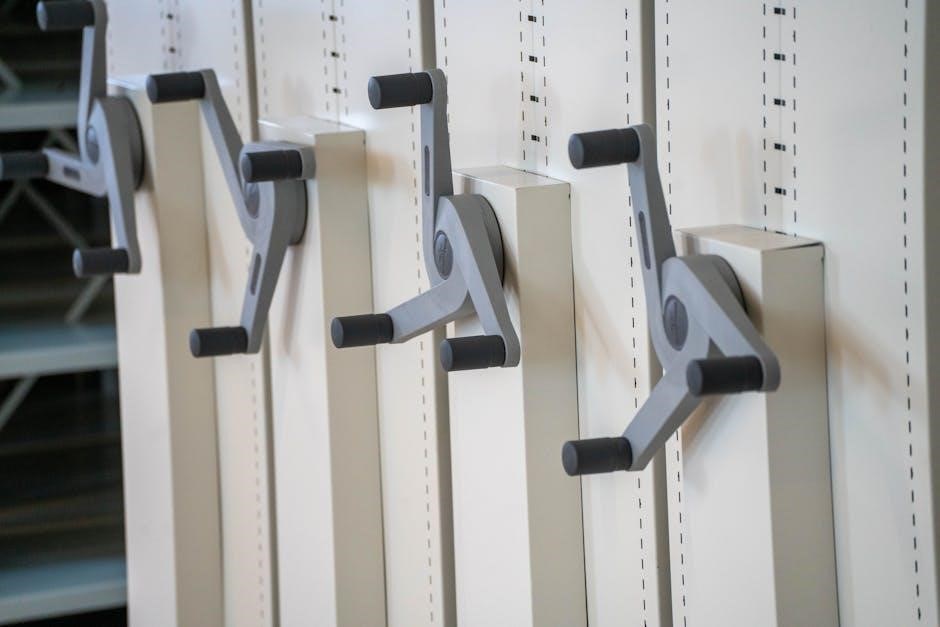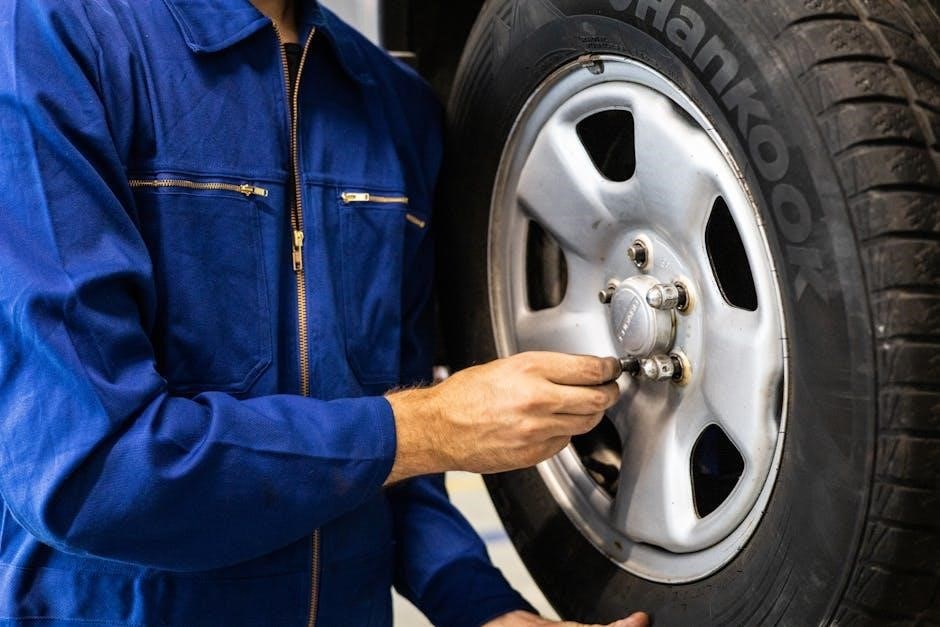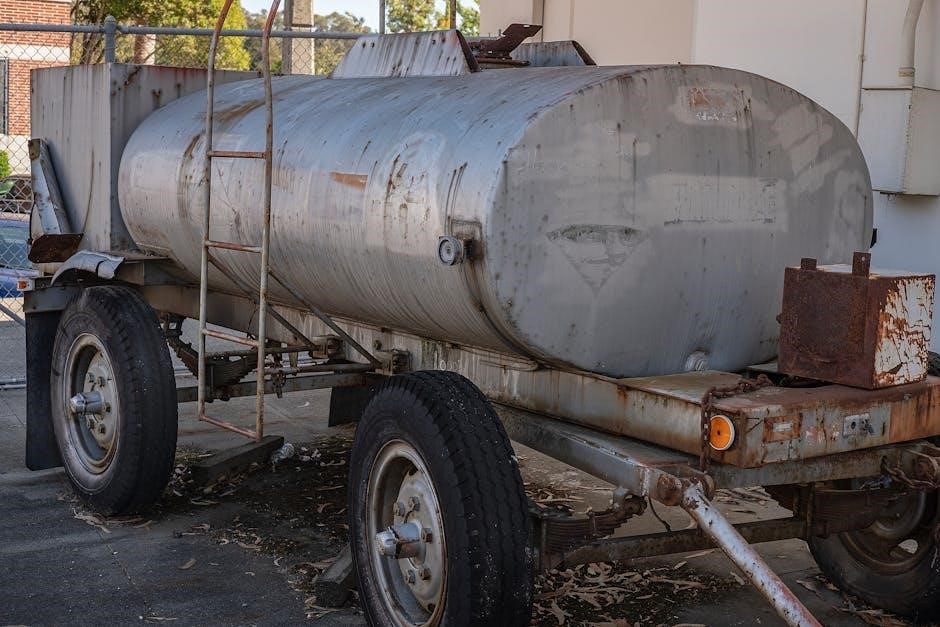Trailer wheel lug nut torque charts provide essential specifications for securing wheels, ensuring proper torque to prevent loosening and potential accidents during towing.
Overview of the Importance of Lug Nut Torque Charts
Lug nut torque charts are critical for ensuring trailer wheels are securely attached, preventing loosening during transit. Proper torque prevents accidents, extends wheel lifespan, and maintains safety. Incorrect torque can lead to wheel detachment or damage. These charts provide precise specifications based on stud size, material, and load capacity, ensuring reliability. Regular re-torquing is essential, especially after initial use or wheel removal. Following these guidelines guarantees optimal performance, safety, and longevity of trailer components, making them indispensable for trailer maintenance and operation.
Why Proper Torque is Essential for Trailer Safety
Proper torque ensures trailer wheels remain securely attached, preventing detachment during transit. Incorrect torque can lead to wheel loosening, potentially causing accidents. Over-tightening may damage wheels or bearings, while under-tightening risks detachment. Torque charts provide precise values for stud size, material, and load capacity, ensuring safety and reliability. Regular re-torquing after initial use or wheel removal is crucial. Aluminum wheels typically require 90-120 ft-lbs, while steel wheels need 120-140 ft-lbs. Adhering to these specifications prevents accidents, protects components, and ensures safe towing, making proper torque indispensable for trailer safety and performance.
Benefits of Using a Trailer Wheel Lug Nut Torque Chart
Using a torque chart ensures safe and secure wheel attachment, prevents loosening, and avoids potential accidents. It also extends wheel and bearing lifespan by applying correct torque values.
Ensuring Safe and Secure Wheel Attachment
Proper torque ensures wheels are securely attached, reducing the risk of loosening during transit. This prevents potential accidents caused by detached wheels. Torque charts provide precise values for different wheel materials and sizes, ensuring a reliable connection. Following these specifications guarantees the wheel is tightly fastened to the axle, maintaining safety and stability while towing. Regular re-torquing after 10, 25, and 50 miles is recommended to maintain security. This practice aligns with manufacturer guidelines, ensuring optimal safety and performance for trailer wheels and bearings.
Preventing Wheel Loosening and Potential Accidents
Proper torque application is critical to prevent wheel loosening, a common cause of trailer-related accidents. Under or over-torquing can lead to nuts becoming loose over time, risking wheel detachment. Torque charts specify exact values for different setups, ensuring secure attachment. Re-torquing after initial miles and during maintenance checks is essential. This consistent practice minimizes the risk of accidents, protecting both the trailer and other road users. Adhering to these guidelines ensures safety and stability, making trailers more reliable and secure for towing.
Extending the Lifespan of Trailer Wheels and Bearings
Proper torque application ensures the longevity of trailer wheels and bearings by preventing uneven wear and excessive stress. Under-torqued wheels may loosen over time, causing friction and heat buildup, which can damage bearings. Conversely, over-torquing can strain wheel studs and bearings, leading to premature failure. By adhering to torque specifications, you distribute force evenly, reducing wear on components. Regular re-torquing and inspections further maximize the lifespan of wheels and bearings, ensuring reliable performance and safety on the road.
Factors Influencing Lug Nut Torque Specifications
Lug nut torque specs are influenced by stud size, wheel material, and wheel size, ensuring proper fitment and safety for varying trailer setups.
Stud Size and Lug Nut Type
Stud size and lug nut type significantly impact torque specifications. Common stud sizes include 1/2″, 9/16″, and 5/8″. Lug nuts may be coned or flat, with torque ranging from 90-140 ft-lbs depending on size. Proper matching ensures secure attachment and prevents damage; Always refer to the chart for specific values to avoid over- or under-tightening, which can lead to safety risks or equipment failure. Correct pairing of stud and nut type is crucial for optimal torque application and trailer safety during operation.
Wheel Material (Steel vs. Aluminum)
Wheel material plays a crucial role in determining torque specifications. Steel wheels typically require higher torque values, often between 120-140 ft-lbs, due to their strength and durability. Aluminum wheels, being lighter and more prone to damage, usually require lower torque, around 90-120 ft-lbs. Proper torque ensures a secure fit without risking damage to the wheel or studs. Always consult the chart for specific material-based recommendations to maintain safety and prevent potential issues during towing or hauling. Correct torque application varies significantly by material, making accurate specification adherence essential for optimal performance and longevity.
Wheel Size and Load Capacity
Wheel size and load capacity significantly influence torque specifications. Larger wheels, such as 16-16.5 inches, often require higher torque values to ensure secure attachment, while smaller wheels (14-15 inches) may need less. Load capacity also plays a role, as heavier loads demand tighter torque to maintain stability and safety. Torque charts typically list specifications based on these factors, ensuring proper tightening without over- or under-tightening. Always refer to the chart for precise values tailored to your trailer’s wheel size and load rating to prevent loosening or damage during operation. Correct torque application is vital for safe and reliable performance.

Understanding Trailer Wheel Lug Nut Torque Charts
Trailer wheel lug nut torque charts offer detailed guidance on torque specifications, ensuring safe and secure wheel attachment. They list torque values based on wheel size, material, and stud size, helping users apply the correct torque to prevent loosening and potential accidents. These charts are essential for proper wheel installation and maintenance, providing clear instructions for accurate torque application. By following the chart, users can ensure their trailer’s wheels are securely fastened, promoting safety and reliability during towing. Regular re-torquing, as specified, further enhances safety and prevents wear. Always consult the chart for precise torque values tailored to your trailer’s specific needs.
How to Read and Interpret the Chart
To effectively use a trailer wheel lug nut torque chart, identify your trailer’s specific details, such as stud size, wheel material, and wheel size. Locate the corresponding row or column in the chart to find the recommended torque value. Ensure you understand the units of measurement, typically in foot-pounds (ft.-lb.). Pay attention to any notes about tightening sequences, such as a star pattern, to ensure even torque application. Refer to the manufacturer’s guidelines if additional clarification is needed. Always double-check the chart to confirm the correct torque specifications for your trailer’s configuration to ensure safety and proper wheel attachment.
Key Information Included in the Chart
A trailer wheel lug nut torque chart includes vital details such as torque specifications, stud sizes, and wheel types. It provides torque values in foot-pounds (ft.-lb.) for different stud diameters, like 1/2″, 9/16″, and 5/8″. The chart also distinguishes between steel and aluminum wheels, as materials affect torque requirements. Additionally, it outlines recommended tightening patterns, such as star or sequential tightening, to ensure even stress distribution. Some charts may include re-torque intervals, like after 10, 25, and 50 miles, to maintain safety and prevent wheel loosening. This information is crucial for proper wheel installation and safe towing operations.
Step-by-Step Guide to Using a Torque Chart
Gather tools like a torque wrench and socket. Locate the correct torque specs in the chart based on stud size and wheel material. Apply the recommended torque values accurately.
Gathering Necessary Tools and Equipment
To properly torque trailer wheel lug nuts, gather essential tools: a torque wrench, impact wrench, and socket matching the lug nut size. Ensure the torque wrench is calibrated for accuracy. Additional items include wheel chocks for safety and a copy of the torque chart specific to your trailer’s specifications. Having the correct tools ensures precise torque application, reducing the risk of under- or over-tightening. Always verify socket compatibility with lug nut types to avoid damage or stripped threads. Proper preparation prevents delays and ensures a secure wheel attachment.
Locating the Correct Torque Specifications
Locate the correct torque specifications by referring to the manufacturer’s torque chart or the owner’s manual. These documents provide precise values based on stud size, wheel material, and load capacity. Online resources, such as PDF downloads from reputable sources, also offer detailed charts tailored to specific trailer setups. Always cross-reference the information to ensure accuracy, as incorrect torque can compromise safety. Manufacturer recommendations are the most reliable source, so prioritize their guidelines when determining the appropriate torque for your trailer wheels.
Applying the Recommended Torque Values
Apply the recommended torque values using a torque wrench, following the star pattern to ensure even pressure. Start by tightening each lug nut in a sequence until snug, then apply the full torque in increments. Refer to the manufacturer’s chart for exact values, which vary by stud size, wheel material, and load capacity. Re-torque after 10, 25, and 50 miles, and periodically thereafter, to maintain safety and prevent loosening. Always double-check the specifications to avoid over- or under-torquing, which can lead to wheel damage or safety risks.
Safety Considerations When Torqueing Lug Nuts
Always use a torque wrench and follow proper tightening patterns to ensure safety. Avoid over- or under-torquing, as this can lead to wheel damage or accidents.
Importance of Using a Torque Wrench
A torque wrench ensures accurate application of specified torque values, preventing wheel damage or detachment. It provides precise control, critical for safety and maintaining structural integrity of trailer wheels.
Following Proper Tightening Patterns
Using a star pattern when tightening or re-torquing trailer wheel lug nuts ensures even distribution of torque and prevents wheel warping. This method reduces stress on individual components, enhancing overall safety and durability.
Avoiding Over- or Under-Torquing
Over-torquing can damage wheels or brake components, while under-torquing risks wheel loosening. Always use a torque wrench and adhere to manufacturer-recommended specifications to ensure safety and avoid potential hazards on the road.

Common Mistakes to Avoid
Ignoring manufacturer guidelines, using incorrect socket sizes, and failing to re-torque after initial use are common errors that can lead to safety issues and wheel damage.
Overlooking the Importance of Re-Torquing
Re-torquing trailer wheel lug nuts is crucial after initial tightening and at specified intervals. Many trailer owners neglect this step, risking wheel loosening and potential accidents. Proper re-torquing ensures consistent pressure on the wheel studs, preventing wear and tear. Trailer wheel lug nut torque charts typically recommend checking torque after 10, 25, and 50 miles, and periodically thereafter. Failure to follow these guidelines can lead to uneven stress distribution, which may cause studs to break or wheels to wobble dangerously. Always refer to the manufacturer’s specifications for precise intervals to maintain safety and prevent costly repairs.
Using Incorrect Socket Sizes
Using the wrong socket size for trailer wheel lug nuts can lead to improper torque application, potentially causing damage to the wheel studs or nuts. Incorrect sockets may slip, rounding the lug nuts and making them difficult to tighten securely. This can result in loose wheels, reduced safety, and increased risk of accidents. Always ensure the socket matches the lug nut size exactly, as specified in the trailer wheel lug nut torque chart; Proper fitment guarantees accurate torque application and prevents potential damage to the wheel assembly. Using the correct tools is essential for maintaining safety and reliability while towing or hauling.
Ignoring Manufacturer Recommendations
Ignoring manufacturer recommendations for trailer wheel lug nut torque can lead to unsafe conditions and potential accidents. Each trailer and wheel combination has specific torque requirements based on factors like stud size, wheel material, and load capacity. Deviating from these guidelines can result in under- or over-tightening, causing wheel damage, stud stripping, or loose wheels while towing. Always refer to the manufacturer’s torque chart to ensure proper tightening and maintain safety. Failure to follow these recommendations can compromise the integrity of the wheel assembly and put both the trailer and occupants at risk. Adhering to these guidelines is crucial for reliable and safe operation.

Torque Wrenches and Tools
A torque wrench is essential for accurately applying the correct torque to trailer wheel lug nuts, ensuring safety and preventing loosening or damage during towing.
Choosing the Right Torque Wrench for the Job
Selecting the correct torque wrench ensures accurate lug nut tightening. Consider the torque range, socket size, and type (click or beam). Match the wrench to your trailer’s stud size and material for precise torque application. Calibration is crucial for maintaining accuracy. Using the wrong wrench can lead to under- or over-tightening, risking safety and equipment damage. Always refer to the manufacturer’s torque chart for compatibility and specifications. A properly chosen torque wrench guarantees secure wheel attachment and safe towing conditions.
Calibrating Your Torque Wrench
Calibrating your torque wrench is crucial for ensuring accurate torque application. Start by referencing the manufacturer’s instructions for specific calibration steps. Use a torque wrench calibration tool or visit a professional service if unsure. Regular calibration prevents inaccuracies that could lead to under- or over-tightening lug nuts. Always check the wrench before use, especially after prolonged storage or heavy-duty tasks. Proper calibration ensures reliable torque values, safeguarding your trailer’s wheels and bearings from damage. Regular maintenance and checks are essential for maintaining tool accuracy and operational safety.
Using Sockets Designed for Lug Nuts
Using sockets specifically designed for lug nuts ensures a secure fit and prevents rounding or damage to the nuts. Always match the socket size to the lug nut size, as specified in the torque chart. A proper fit minimizes slippage and ensures accurate torque application. Avoid using universal or ill-fitting sockets, as they can cause inconsistencies and potential safety hazards. Refer to your trailer’s torque chart for recommended socket types and sizes, ensuring compatibility with your torque wrench. This step is critical for maintaining even pressure and achieving the correct torque specifications for safe and reliable wheel attachment.

Checking and Re-Torquing Lug Nuts
Regularly check and re-torque lug nuts at specified intervals, such as after 10, 25, and 50 miles, to ensure safety and prevent potential issues.
Recommended Intervals for Re-Torquing
Re-torquing lug nuts at specific intervals is crucial for maintaining safety and preventing wheel loosening. It is recommended to check and re-torque lug nuts after the initial 10 miles, then again at 25 miles, and finally at 50 miles. After these initial checks, periodic re-torquing should be performed during regular maintenance or service. This ensures that the wheels remain securely attached to the axle, even after prolonged use or varying road conditions; Always refer to the manufacturer’s specifications or the trailer wheel lug nut torque chart for exact intervals and torque values to avoid under- or over-tightening, which can lead to safety hazards or equipment damage.
Signs That Lug Nuts Need to Be Re-Torqued
Several indicators suggest that lug nuts require re-torquing. If you notice any looseness or vibration while driving, it may signal that the lug nuts have become loose. Additionally, visible rust or corrosion on the studs or nuts can weaken their hold, necessitating re-torquing. After hitting a pothole or curb, it’s wise to check the torque. Lastly, if the trailer has been stationary for an extended period, re-torquing ensures all components are secure before towing again. Always refer to the trailer wheel lug nut torque chart for proper specifications to maintain safety and prevent potential accidents.
Documentation and Record-Keeping
Maintaining detailed records of lug nut torque checks and adjustments is crucial for trailer maintenance. Keep a log of all torque inspections, including dates, mileage, and the torque values applied. This documentation helps track compliance with safety standards and manufacturer recommendations. Regular audits of these records ensure consistency and adherence to proper procedures. Digital tools or spreadsheets can simplify organization and accessibility. Additionally, storing a copy of the trailer wheel lug nut torque chart with the records provides quick reference for future checks. Accurate record-keeping supports trailer integrity and long-term safety.

Manufacturer Recommendations
Always adhere to manufacturer-specific torque charts for trailer wheels to ensure safety and prevent damage. Deviating from these guidelines can lead to wheel failure or unsafe towing conditions.
Why Manufacturer Specs Should Be Followed
Manufacturer torque specifications are tailored to the specific design and materials of your trailer wheels, ensuring proper fit and safety. Using these specs guarantees the correct torque values for your lug nuts, preventing under- or over-tightening. Over-tightening can damage wheels or brakes, while under-tightening risks wheel loosening and potential accidents. Manufacturers consider factors like wheel material, stud size, and load capacity when creating these guidelines. Following these recommendations ensures optimal performance, safety, and longevity of your trailer’s wheels and bearings. Ignoring them can lead to costly repairs or dangerous situations on the road. Always refer to the manufacturer’s torque chart for accuracy and reliability.
Locating Manufacturer-Specific Torque Charts
Manufacturer-specific torque charts are typically found in the owner’s manual or on the manufacturer’s official website. Many companies provide downloadable PDF versions of these charts, which list precise torque values for different wheel configurations. These charts account for factors like stud size, wheel material, and load capacity. For example, aluminum wheels often require lower torque values than steel wheels. Consulting the manufacturer’s resources ensures you access accurate and reliable information tailored to your specific trailer setup. Always verify the source to guarantee authenticity and safety. Using these charts helps prevent errors and ensures proper wheel installation and maintenance.
Understanding the Consequences of Deviating
Deviation from manufacturer-recommended torque specifications can lead to serious safety issues. Over-torquing may damage wheels or brake components, while under-torquing can cause lug nuts to loosen, risking wheel separation. Improper torque can also void warranties and lead to equipment failure. Inaccurate torque application increases the risk of accidents, particularly during towing. Always adhere to the guidelines provided in the torque chart to ensure safety and prevent potential mechanical failures. Ignoring these specifications can have severe consequences, including legal liabilities and costly repairs. Proper torque adherence is crucial for maintaining trailer integrity and user safety on the road.

Accessing Trailer Wheel Lug Nut Torque Charts
Trailer wheel lug nut torque charts are available online as PDF downloads, in owner’s manuals, or through manufacturer websites, ensuring easy access to precise specifications.
Online Resources and PDF Downloads
Trailer wheel lug nut torque charts are widely available online as downloadable PDFs, offering convenient access to essential torque specifications. These resources, often provided by manufacturers like Lippert Components or Diamond C, detail precise torque values based on stud size, wheel material, and load capacity. Websites and forums dedicated to trailer maintenance frequently share these charts, ensuring users can easily find the correct specifications for their equipment. By downloading these PDFs, trailer owners can ensure safe towing practices, proper wheel attachment, and prevention of potential accidents caused by incorrect torque application.
Consulting Owner’s Manuals
Owner’s manuals are a primary source for trailer wheel lug nut torque specifications. They provide detailed charts and guidelines tailored to the specific trailer model, ensuring accurate torque application. Manuals often outline the correct torque values based on factors like wheel material and stud size, crucial for safety and durability. Regularly consulting these manuals helps prevent over- or under-torquing, which can lead to wheel damage or loosening. They also emphasize the importance of re-torquing after initial use and at recommended intervals, making them an indispensable resource for proper trailer maintenance and safe operation.
Industry Standards and Regulations
Industry standards and regulations play a critical role in determining torque specifications for trailer wheel lug nuts. Organizations such as the Department of Transportation (DOT) and the Society of Automotive Engineers (SAE) establish guidelines to ensure safety and durability. These standards are based on factors like stud size, wheel material, and load capacity, providing clear torque ranges to avoid over- or under-tightening. Compliance with these regulations is essential for legal and safety reasons, as improper torque can lead to wheel failure and accidents. Always refer to industry-recognized torque charts to meet these requirements and ensure reliable performance. Adherence is non-negotiable for safe towing operations.

Proper Wheel Maintenance Beyond Torque
Regular inspection of trailer wheels and lug nuts is crucial. Check for wear, damage, or corrosion and replace components as needed. Proper lubrication of wheel bearings and nuts ensures smooth operation and prevents premature wear, enhancing safety and durability over time.
Inspecting Wheels and Lug Nuts Regularly
Regularly inspecting trailer wheels and lug nuts is vital for maintaining safety and preventing potential issues. Check for signs of wear, damage, or corrosion on both the wheels and nuts. Ensure all components are in good condition and properly aligned. Look for loose or over-tightened nuts, as both can lead to problems. If damage or wear is found, replace the affected parts immediately. This practice helps prevent wheel loosening during use and reduces the risk of accidents. Regular inspections also ensure that torque specifications are maintained over time, keeping your trailer secure and operational. Always refer to your owner’s manual for specific guidance.
Addressing Damaged or Worn-Out Components
Addressing damaged or worn-out components on trailer wheels is critical to ensure safety and reliability. If any part, such as a lug nut or wheel stud, shows signs of wear or damage, it must be replaced immediately. Using damaged components can lead to wheel loosening, which poses serious safety risks. Always replace parts with those meeting or exceeding original specifications. After replacing any component, refer to the trailer’s torque chart to ensure all nuts are tightened to the recommended torque values. Proper replacement and torque ensure the trailer’s stability and prevent potential accidents during towing or operation.
Lubrication and Cleaning Practices
Lubrication and cleaning are vital for maintaining trailer wheel components. Regularly clean lug nuts and studs to remove dirt and grime, ensuring proper torque application. Apply a thin layer of lubricant to threads before tightening to prevent rust and corrosion. Avoid over-lubrication, as it may attract debris. Cleanliness ensures accurate torque readings and prevents damage. Lubricate after cleaning and before torqueing to maintain optimal conditions. Proper maintenance extends component lifespan and ensures safety. Always refer to the torque chart for specific lubrication recommendations, as improper practices can lead to component failure or safety risks. Regular cleaning and lubrication are essential for reliable trailer operation.
